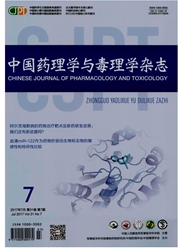

 中文摘要:
中文摘要:
目的探讨川芎嗪抑制P2X3受体介导慢性神经病理痛的作用途径。方法制备大鼠坐骨神经慢性压迫性损伤(CCI)神经病理痛模型,于d 2起ip川芎嗪100 mg·kg^-1,每天1次,共14 d。免疫组织化学法观察CCI大鼠L4/L5段背根神经节P2X3受体的表达,全细胞膜片钳技术测定新鲜分离的L4/L5段背根神经节三磷酸腺苷(ATP)和α,β-亚甲基三磷酸腺苷(α,β-meATP)激活的电流。结果与正常对照组比较,正常大鼠ip川芎嗪14 d,L4/L5段背根神经节P2X3受体表达、ATP激活电流和α,β-meATP激活电流无明显变化,假手术组亦无明显变化。与假手术组比较,CCI模型组大鼠L4/L5段背根神经节P2X3受体的表达、ATP和α,β-meATP激活电流明显增强。CCI大鼠ip川芎嗪14 d,L4/L5段背根神经节P2X3受体表达、ATP和α,β-meATP激活电流较CCI模型组明显降低。结论川芎嗪可抑制CCI大鼠L4/L5段背根神经节P2X3受体的表达,从而对P2X3受体介导的神经病理痛产生抑制作用。
 英文摘要:
英文摘要:
AIM To investigate the pathway of ligustrazine to alleviate neuropathic pain induced by P2X3 receptor. METHODS Chronic constriction injury (CCI) rat model with neuropathic pain was prepared. From d 2, ligustrazine 100 mg·kg^-1 was given ip once daily for 14 d. The P2X3 receptor expression in L4/L5 dorsal root ganglion (DRG) neurons was detected with immunohistochemistry assay. Whole-cell patch-clamp technique was used to measure adenosine triphospate(ATP) and α,β- methylene-ATP (α,β-meATP) activated currents in freshly isolated DRG neurons of CCI rats. RESULTS Compared with normal control, the expression of P2X3 receptors and ATP- activated currents (IATp) and α,β-meATP-activated currents (Iα,β-meATP) in L4/L5 DRG neu- rons did not change after ligustrazine was given to normal rats for 14 d. There was also no significant difference between sham and normal control groups. The expression of P2X3 recep- tor, IATP and Iα,β-meATP in L4/L5 DRG neurons of CCI model rats significantly increased compared with sham group. After ligustrazine was given ip to CCI model rats for 14 d, the expression of P2X3 receptor, IATP and Iα,β-meATP in L4/Ls DRG neurons decreased significantly. CONCLUSION Ligustrazine can alleviate neuropathic pain induced by P2X3 receptor, which may be related to its inhibitory effect on the expression of P2X3 receptor in L4/L5 DRG of CCI rats.
 同期刊论文项目
同期刊论文项目
 同项目期刊论文
同项目期刊论文
 期刊信息
期刊信息
